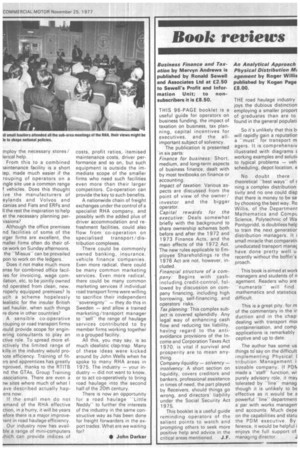Rook reviews
Page 63

If you've noticed an error in this article please click here to report it so we can fix it.
Business Finance and Taxation by Mervyn Andrews is published by Ronald Sewell and Associates Ltd at £2.50 to Sewell's Profit and Information Unit; to nonsubscribers it is £8.50.
THIS 96-PAGE booklet is a useful guide for operators on business funding, the impact of taxation on business, tax planning, capital incentives for executives, and the allimportant subject of solvency.
The publication is presented in six parts: Finance for business: Short, medium, and long-term aspects of business finance, dealt with by most textbooks on finance or accounting.
Impact of taxation: Various aspects are discussed from the point of view of the owner/ investor and the bigger operator.
Capital rewards for the executive: Deals somewhat briefly with the background to share ownership schemes both before and after the 1972 and 1973 Finance Acts, and the main effects of the 1972 Act. The new rules applicable to Employee Shareholdings re the 1976 Act are not, however, included.
Financial structure of a company: Begins with cashincluding credit-control, followed by discussion on company financing, including high borrowing, self-financing, and operators' risks.
Tax planning: This complex subject is covered splendidly. Any legal way of enhancing cash flow and reducing tax liability, having regard to the antiavoidance provisions of the Income and Corporation Taxes Act 1970, is vital if survival and prosperity are to mean anything.
Company liquidity — solvency — insolvency: A short section on liquidity, covers creditors and bankers, professional assistance in times of need, the part played by Receivers, should things go wrong, and directors' liability under the Social Security Act 1975.
This booklet is a useful guide reminding operators of the salient points to watch and -prompting others to seek more positive help and advice in the
critical areas mentioned. J.F. An Analytical Approach Physical Distribution Mi agement by Roger Willis published by Kogan Page £8.00.
THE road haulage industry joys the dubious distinction employing a smaller proport of graduates than are to found in the general populati.
So it's unlikely that this I), will rapidly gain a reputation a "must" for transport m agers. It is.comprehensiv illustrated with diagrams working examples and solutio to typical problems — veh scheduling, depot location, e
No doubt there theoretical "best ways" of r fling a complex distribution tivity and no one could cusp that there is money to be sa: by choosing the best way. Ro Willis, of the Department Mathematics and Compu Science, Polytechnic of Wa Pontypridd, is doubtless help to train the, next generatior distribution managers. It i small miracle that comparatk uneducated transport manac have done pretty well u recently without the boffin's proach.
This book is aimed at work managers and students of n agement. Readers who are 'numeratewill find mathematics and statistics difficult.
This is a.great pity, for m of the commentary in the in duction and in the chapi dealing with transport mot containerisation, and comp applications is remarkably ceptive and up to date.
The author has some usthings to' say on the difficult implementing Physical [ tribution Management i. sizeable company. If PDN made a "staff" function, wr purely advisory role, it may tolerated by "line" manag though it is unlikely to be effective as it would be a powerful "line" department a par with works managerr and accounts. Much depe on the capabilities and statu the PDM executive. By ference, it would be helpful i enjoys the full support of managing director.










































































































